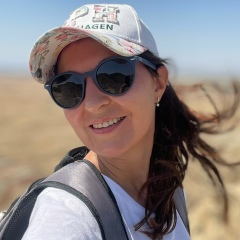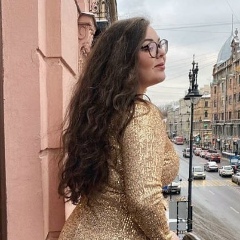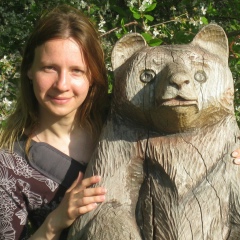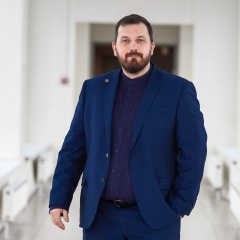Ланчанское чудо
Шел VIII век от Рождества Христова. В Церкви Сан - Легонций старинного итальянского города Ланчано совершалось Таинство Евхаристии. Но в сердце одного из священников, служившего в тот день Литургию, вдруг возникло сомнение, истинны ли Тело и Кровь Господни, сокрытые под видом хлеба и вина. Хроники не донесли до нас имени этого иеромонаха, но зародившееся в его душе сомнение стало причиной Евхаристического чуда, почитаемого до сей поры.
Священник гнал от себя сомнения, но они назойливо возвращались вновь и вновь. "Почему я должен верить, что хлеб перестает быть хлебом, а вино становится Кровью? Кто это докажет? Тем более, что внешне они никак не изменяются и не изменялись никогда. Наверное, это всего лишь символы, просто воспоминание о тайной вечере:"
В ту ночь, когда Он был предан, Он взял хлеб: благословил, преломил и подал ученикам Своим, говоря: "Примите, вкусите: сие есть тело Мое, которое за вас преломляется во оставление грехов". Также и чашу, говоря: "Пейте из нее все: сия есть Кровь Моя Нового Завета, за вас и за многих изливаемая во оставление грехов".
Со страхом произносил священник святые слова Евхаристического канона, но сомнения продолжали мучить его. Да, Он, жертвенный агнец, мог Своей Божественной властью обратить вино в кровь, а хлеб - в Плоть. Все мог Он, пришедший по воле Отца Небесного. Но Он ушел давно, оставив этот грешный мир и дав ему в утешение Свои святые слова и Свое благословение: И, может быть, Свои Плоть и Кровь? Но возможно ли это? Не ушло ли подлинное Таинство причастия вместе с Ним в мир горний? Не стала ли святая Евхаристия лишь обрядом - и не более того? Тщетно пытался священник восстановить в душе мир и веру. Между тем, пресуществление произошло. Со словами молитвы он преломил Евхаристический Хлеб, и тут крик изумления огласил небольшую церковь. Под пальцами иеромонаха преломляемый Хлеб вдруг превратился во что-то другое - он не сразу понял, во что именно. Да и в чаше было уже не вино - там была густая алая Жидкость похожая на: кровь. Ошеломленный священник смотрел на предмет, который был у него в руках: это был тонкий срез Плоти, напоминающий мышечную ткань человеческого тела. Монахи окружили священника, пораженные чудом, не в силах сдержать изумления. А он исповедал перед ними свои сомнения, разрешенные таким чудесным образом. Окончив святую литургию, молча упал на колени и погрузился в долгую молитву. О чем молился он тогда? Благодарил за данный свыше знак? Просил прощения за свое маловерие? Мы этого не узнаем никогда. Но подлинно известно одно: с тех пор в городе Ланчано двенадцать веков хранятся чудесные Кровь и Плоть, материализовавшиеся во время Евхаристии в церкви Сан - Легонций (ныне Сан - Франческо). Весть о чуде быстро облетела тогда близлежащие города и области, и в Ланчано потянулись вереницы паломников.
Прошли века - и чудесные Дары стали объектом внимания ученых. С 1574 года над Святыми Дарами велись различные опыты и наблюдения, а с начала 1970-х годов они стали проводиться на экспериментальном уровне. Но данные, полученные одними учеными, не удовлетворяли других. Профессор медицинского факультета Сиенского университета Одоардо Линолди, крупный специалист в области анатомии, паталогической гистологии, химии и клинической микроскопии, проводил со своими коллегами исследования в ноябре 1970 и в марте 1971 годов и пришел к следующим выводам. Святые Дары, хранящиеся в Ланчано с VIII века, представляют собой подлинные человеческие Плоть и Кровь. Плоть является фрагментом мышечной ткани сердца, содержит в сечении миокард, эндокард и блуждающий нерв. Возможно, фрагмент плоти содержит также левый желудочек - такой вывод позволяет сделать значительная толщина миокарда, находящаяся в тканях Плоти. И Плоть, и Кровь относятся к единой группе крови: АБ. К ней же относится и Кровь, обнаруженная на Туринской Плащанице. Кровь содержит протеины и минералы в нормальных для человеческой крови процентных соотношениях. Ученые особо подчеркнули: более всего удивительно то, что Плоть и Кровь двенадцать веков сохраняются под воздействием физических, атмосферных и биолог
Шел VIII век от Рождества Христова. В Церкви Сан - Легонций старинного итальянского города Ланчано совершалось Таинство Евхаристии. Но в сердце одного из священников, служившего в тот день Литургию, вдруг возникло сомнение, истинны ли Тело и Кровь Господни, сокрытые под видом хлеба и вина. Хроники не донесли до нас имени этого иеромонаха, но зародившееся в его душе сомнение стало причиной Евхаристического чуда, почитаемого до сей поры.
Священник гнал от себя сомнения, но они назойливо возвращались вновь и вновь. "Почему я должен верить, что хлеб перестает быть хлебом, а вино становится Кровью? Кто это докажет? Тем более, что внешне они никак не изменяются и не изменялись никогда. Наверное, это всего лишь символы, просто воспоминание о тайной вечере:"
В ту ночь, когда Он был предан, Он взял хлеб: благословил, преломил и подал ученикам Своим, говоря: "Примите, вкусите: сие есть тело Мое, которое за вас преломляется во оставление грехов". Также и чашу, говоря: "Пейте из нее все: сия есть Кровь Моя Нового Завета, за вас и за многих изливаемая во оставление грехов".
Со страхом произносил священник святые слова Евхаристического канона, но сомнения продолжали мучить его. Да, Он, жертвенный агнец, мог Своей Божественной властью обратить вино в кровь, а хлеб - в Плоть. Все мог Он, пришедший по воле Отца Небесного. Но Он ушел давно, оставив этот грешный мир и дав ему в утешение Свои святые слова и Свое благословение: И, может быть, Свои Плоть и Кровь? Но возможно ли это? Не ушло ли подлинное Таинство причастия вместе с Ним в мир горний? Не стала ли святая Евхаристия лишь обрядом - и не более того? Тщетно пытался священник восстановить в душе мир и веру. Между тем, пресуществление произошло. Со словами молитвы он преломил Евхаристический Хлеб, и тут крик изумления огласил небольшую церковь. Под пальцами иеромонаха преломляемый Хлеб вдруг превратился во что-то другое - он не сразу понял, во что именно. Да и в чаше было уже не вино - там была густая алая Жидкость похожая на: кровь. Ошеломленный священник смотрел на предмет, который был у него в руках: это был тонкий срез Плоти, напоминающий мышечную ткань человеческого тела. Монахи окружили священника, пораженные чудом, не в силах сдержать изумления. А он исповедал перед ними свои сомнения, разрешенные таким чудесным образом. Окончив святую литургию, молча упал на колени и погрузился в долгую молитву. О чем молился он тогда? Благодарил за данный свыше знак? Просил прощения за свое маловерие? Мы этого не узнаем никогда. Но подлинно известно одно: с тех пор в городе Ланчано двенадцать веков хранятся чудесные Кровь и Плоть, материализовавшиеся во время Евхаристии в церкви Сан - Легонций (ныне Сан - Франческо). Весть о чуде быстро облетела тогда близлежащие города и области, и в Ланчано потянулись вереницы паломников.
Прошли века - и чудесные Дары стали объектом внимания ученых. С 1574 года над Святыми Дарами велись различные опыты и наблюдения, а с начала 1970-х годов они стали проводиться на экспериментальном уровне. Но данные, полученные одними учеными, не удовлетворяли других. Профессор медицинского факультета Сиенского университета Одоардо Линолди, крупный специалист в области анатомии, паталогической гистологии, химии и клинической микроскопии, проводил со своими коллегами исследования в ноябре 1970 и в марте 1971 годов и пришел к следующим выводам. Святые Дары, хранящиеся в Ланчано с VIII века, представляют собой подлинные человеческие Плоть и Кровь. Плоть является фрагментом мышечной ткани сердца, содержит в сечении миокард, эндокард и блуждающий нерв. Возможно, фрагмент плоти содержит также левый желудочек - такой вывод позволяет сделать значительная толщина миокарда, находящаяся в тканях Плоти. И Плоть, и Кровь относятся к единой группе крови: АБ. К ней же относится и Кровь, обнаруженная на Туринской Плащанице. Кровь содержит протеины и минералы в нормальных для человеческой крови процентных соотношениях. Ученые особо подчеркнули: более всего удивительно то, что Плоть и Кровь двенадцать веков сохраняются под воздействием физических, атмосферных и биолог
Lanchan Miracle
Shel VIII century from the birth of Christ. In the Church of San Legontos of the ancient Italian city of Lanciano the Sacrament of the Eucharist was performed. But in the heart of one of the priests who served the Liturgy on that day, there suddenly arose a doubt whether the Body and Blood of the Lord, hidden under the guise of bread and wine, were true. The chronicles did not inform us of the name of this hieromonk, but the doubt that originated in his soul became the cause of the Eucharistic miracle revered to this day.
The priest persecuted doubts from himself, but they persistently returned again and again. “Why should I believe that bread ceases to be bread, and wine becomes Blood? Who will prove it? Especially since apparently they never change and never change. Probably, these are just symbols, just a reminder of a secret evening:”
That night, when He was betrayed, He took bread: He blessed, broke, and gave to His disciples, saying: "Receive, eat: this is My body, which is broken for you for the remission of sins." Also the cup, saying: "Drink everything from it: this is My Blood of the New Testament, poured out for you and for many for the remission of sins."
With fear, the priest uttered the holy words of the Eucharistic canon, but doubts continued to torment him. Yes, He, the sacrificial lamb, could, through His divine power, turn wine into blood, and bread into flesh. All He could, who came at the behest of the Heavenly Father. But He left a long time ago, leaving this sinful world and giving Him in consolation His holy words and His blessing: And, perhaps, His Flesh and Blood? But is it possible? Has not the true sacrament of the sacrament gone with him into the upper world? Has the Holy Eucharist become just a rite - and nothing more? In vain the priest tried to restore peace and faith in his soul. Meanwhile, transubstantiation has happened. With the words of prayer, he broke the Eucharistic Bread, and then a small church announced the cry of amazement. Under the fingers of Hieromonk the refracted Bread suddenly turned into something else - he did not immediately understand what exactly. Yes, and in the bowl was no longer wine - there was a thick scarlet Liquid similar to: blood. The stunned priest looked at the object that was in his hands: it was a thin section of Flesh, resembling the muscular tissue of the human body. The monks surrounded the priest, struck by a miracle, unable to restrain amazement. And he confessed to them his doubts resolved in such a miraculous way. After graduating from the holy liturgy, he silently fell to his knees and plunged into a long prayer. What did he pray for then? Gave thanks for this sign from above? I apologize for my lack of faith? We will never know. But one thing is truly known: since then, for twelve centuries, the wonderful Blood and Flesh, which materialized during the Eucharist in the Church of San Legontius (now San Francesco), has been kept in the city of Lanciano. The news of the miracle quickly spread around the nearby cities and regions, and a series of pilgrims stretched to Lanciano.
Centuries passed - and the wonderful Gifts became the object of attention of scientists. Since 1574, various experiments and observations have been conducted on the Holy Gifts, and since the beginning of the 1970s they have been conducted at an experimental level. But the data obtained by some scientists did not satisfy others. Odoardo Linoldi, a professor at the Faculty of Medicine at the University of Siena, a prominent specialist in anatomy, pathological histology, chemistry and clinical microscopy, conducted research with his colleagues in November 1970 and March 1971 and came to the following conclusions. The Holy Gifts, which have been stored in Lanciano since the 8th century, are genuine human Flesh and Blood. The flesh is a fragment of the muscle tissue of the heart, contains in the cross section of the myocardium, endocardium and the vagus nerve. Perhaps the fragment of flesh also contains the left ventricle - such a conclusion allows a significant thickness of the myocardium in the tissues of the Flesh to be made. Both Flesh and Blood belong to a single blood group: AB. It also includes the Blood, found on the Shroud of Turin. Blood contains proteins and minerals in the normal percentage of human blood. Scientists have emphasized: it is most surprising that the flesh and blood of twelve centuries are preserved under the influence of physical, atmospheric and biologist
Shel VIII century from the birth of Christ. In the Church of San Legontos of the ancient Italian city of Lanciano the Sacrament of the Eucharist was performed. But in the heart of one of the priests who served the Liturgy on that day, there suddenly arose a doubt whether the Body and Blood of the Lord, hidden under the guise of bread and wine, were true. The chronicles did not inform us of the name of this hieromonk, but the doubt that originated in his soul became the cause of the Eucharistic miracle revered to this day.
The priest persecuted doubts from himself, but they persistently returned again and again. “Why should I believe that bread ceases to be bread, and wine becomes Blood? Who will prove it? Especially since apparently they never change and never change. Probably, these are just symbols, just a reminder of a secret evening:”
That night, when He was betrayed, He took bread: He blessed, broke, and gave to His disciples, saying: "Receive, eat: this is My body, which is broken for you for the remission of sins." Also the cup, saying: "Drink everything from it: this is My Blood of the New Testament, poured out for you and for many for the remission of sins."
With fear, the priest uttered the holy words of the Eucharistic canon, but doubts continued to torment him. Yes, He, the sacrificial lamb, could, through His divine power, turn wine into blood, and bread into flesh. All He could, who came at the behest of the Heavenly Father. But He left a long time ago, leaving this sinful world and giving Him in consolation His holy words and His blessing: And, perhaps, His Flesh and Blood? But is it possible? Has not the true sacrament of the sacrament gone with him into the upper world? Has the Holy Eucharist become just a rite - and nothing more? In vain the priest tried to restore peace and faith in his soul. Meanwhile, transubstantiation has happened. With the words of prayer, he broke the Eucharistic Bread, and then a small church announced the cry of amazement. Under the fingers of Hieromonk the refracted Bread suddenly turned into something else - he did not immediately understand what exactly. Yes, and in the bowl was no longer wine - there was a thick scarlet Liquid similar to: blood. The stunned priest looked at the object that was in his hands: it was a thin section of Flesh, resembling the muscular tissue of the human body. The monks surrounded the priest, struck by a miracle, unable to restrain amazement. And he confessed to them his doubts resolved in such a miraculous way. After graduating from the holy liturgy, he silently fell to his knees and plunged into a long prayer. What did he pray for then? Gave thanks for this sign from above? I apologize for my lack of faith? We will never know. But one thing is truly known: since then, for twelve centuries, the wonderful Blood and Flesh, which materialized during the Eucharist in the Church of San Legontius (now San Francesco), has been kept in the city of Lanciano. The news of the miracle quickly spread around the nearby cities and regions, and a series of pilgrims stretched to Lanciano.
Centuries passed - and the wonderful Gifts became the object of attention of scientists. Since 1574, various experiments and observations have been conducted on the Holy Gifts, and since the beginning of the 1970s they have been conducted at an experimental level. But the data obtained by some scientists did not satisfy others. Odoardo Linoldi, a professor at the Faculty of Medicine at the University of Siena, a prominent specialist in anatomy, pathological histology, chemistry and clinical microscopy, conducted research with his colleagues in November 1970 and March 1971 and came to the following conclusions. The Holy Gifts, which have been stored in Lanciano since the 8th century, are genuine human Flesh and Blood. The flesh is a fragment of the muscle tissue of the heart, contains in the cross section of the myocardium, endocardium and the vagus nerve. Perhaps the fragment of flesh also contains the left ventricle - such a conclusion allows a significant thickness of the myocardium in the tissues of the Flesh to be made. Both Flesh and Blood belong to a single blood group: AB. It also includes the Blood, found on the Shroud of Turin. Blood contains proteins and minerals in the normal percentage of human blood. Scientists have emphasized: it is most surprising that the flesh and blood of twelve centuries are preserved under the influence of physical, atmospheric and biologist
У записи 1 лайков,
0 репостов.
0 репостов.
Эту запись оставил(а) на своей стене Слава Воскресенский





















